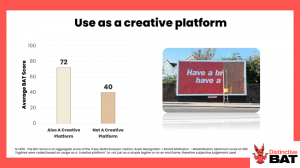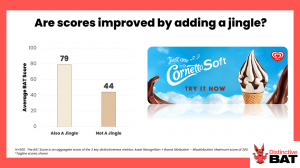New Research Reveals What Makes a Tagline Truly Distinctive
Meta-analysis of 500+ global taglines uncovers the creative and structural secrets behind brand memorability.
The key consideration is to ensure you really commit behind the tagline, especially in thinking about it as more than just a sign-off tagline. Use it as your totem pole for creativity”
DUBLIN, IRELAND, October 8, 2025 /EINPresswire.com/ -- Why do some taglines become cultural touchstones, while others vanish overnight? New research by Distinctive BAT, a distinctive asset research consultancy, highlights the key factors that make taglines distinctive.— Cathal Gillen
Taglines are often held up as one of the best examples of Distinctive Brand Assets. The likes of “Just Do It” and “I’m Lovin’ It” are iconic examples where the brand owner instantly comes to mind. But there is so often a big disparity in performance between the good and the not so good when it comes to distinctiveness performance.
Distinctive BAT sought to explore whether there were specific factors behind their success; insights that could be utilised when developing a new tagline. Distinctive BAT conducted a meta-analysis of more than 500 taglines from their database, across multiple categories and markets. These were reviewed through different factors such as length in words, time in market, whether it is used as a jingle or not, and whether it is emotive or functional in composition, amongst others. These were then analysed using the BAT score, an aggregate score of key distinctive measures made up of Asset Recognition + Brand Attribution – Misattribution. The global study of 500 taglines reveals the surprising traits that separate memorable slogans from the forgettable.
The Best Taglines Are Creative Platforms, Not Just Sign-Offs
The key factor driving distinctiveness success was for those taglines that also featured as a consumer-facing manifestation of the “big idea” or creative platform, versus simply as a sign-off. Cathal Gillen, Co-Founder and Head of Strategy at Distinctive BAT commented “The hardest-working taglines are more than just a tagline. They are a jumping-off point for so much creativity. This is something we have seen time and time again within client research and it plays out significantly within the meta-analysis. Often, taglines are not creatively applied and are used only as a 30-second advert sign-off. It’s naive to think this will be enough. The hardest-working taglines are more than just a tagline. KitKat or Snickers are examples of brands that consistently use a tagline, but they have also made them the hero of their advertising and a central tenet of their creative. This platform provides the perfect amount of focus and direction for creatives to do brilliant work developing top-notch advertising”.
Longevity Pays Off: It Aids Reach & Frequency
One of the other most important factors is time in market. Cathal commented “One of the biggest reasons brands struggle to embed a tagline is the lack of airtime and longevity. Many taglines last only as long as a brand campaign related to the latest positioning objective or brand challenge. Unsurprisingly, the longer the tagline has been live, in general, the higher the scores. Repetition is a huge factor in embedding any asset, and the longer a tagline is live, the higher the reach and frequency over the long term.”
More Words, More Memory?
A number of other factors of importance were also uncovered through the research.
The number of words also had an influence, with longer taglines generally indexed higher. “We presumed shorter taglines would have indexed higher, however, we saw this trend the other way, with uplifts in scores as the number of words increased,” commented Cathal. “There is often an ask to be as punchy as possible in nearly any walk of life, including advertising, however this doesn’t play out in the data. This would suggest that those extra few words might help tell a bit more of a story, versus punchier taglines like “Eat Fresh” or “King of Beers”, helping contribute to a few additional layers in aiding memory storage and recall. This isn’t to suggest we recommend adding words for the sake of it, more so that if you do land on something you feel has potential, don’t over-edit or rule it out simply because it’s that bit longer.”
The addition of the brand name to the tagline also added incrementally to distinctiveness. “Repetition of the brand name within the tagline brings an advantage in driving distinctiveness, helping embed it within memory structures. Aside from helping improve the chances of the tagline sticking, having the brand name mentioned further aids brand linkage to advertising,” advised Cathal.
The research also looked at the composition of taglines, for example, the differences between those that are more abstract in structure versus not, and also those that may lean more into emotion versus those that are more functional. The research found small to moderate jumps for the more abstract taglines of the world, i.e. those that require slightly more comprehension, suggesting it helps the tagline stand out (e.g. Heineken “Open Your World” versus Michelob ULTRA “Superior Light Beer”). There were also some small uplifts for more emotive taglines, those that are more humorous, playful, or nostalgic in nature.
The Jingle Factor?
The research uncovered that there was a substantial jump (35-point uplift) for taglines that also featured as a jingle. “The sticky earworm characteristics of jingles also translate back to taglines when used in their purest form as written text. The double impact of usage is also likely a key driver. Any time we see a golden thread through different types of distinctive assets, we see big improvements all round. The use of an additional asset type undoubtedly helps embed the other,” added Cathal. “Jingles are very much underutilised in modern times and could be said to be a microcosm of marketing, an incredibly hard-working device that has gone out of favour for trendier concepts. If looking to lean on a tagline as a distinctive asset, make sure you tease out the possibility in also using it as a jingle.”
Totem Pole For Creative
“We hope this research will provide some thought to marketers and creatives in the development of taglines” furthered Cathal. “The key consideration is to ensure you really commit behind the tagline, especially in thinking about it as more than just a sign-off tagline. Use it as your totem pole for creativity”.
Cathal Gillen
Distinctive BAT
+353 87 653 0921
cathal@distinctivebat.com
Visit us on social media:
LinkedIn
X
Legal Disclaimer:
EIN Presswire provides this news content "as is" without warranty of any kind. We do not accept any responsibility or liability for the accuracy, content, images, videos, licenses, completeness, legality, or reliability of the information contained in this article. If you have any complaints or copyright issues related to this article, kindly contact the author above.



